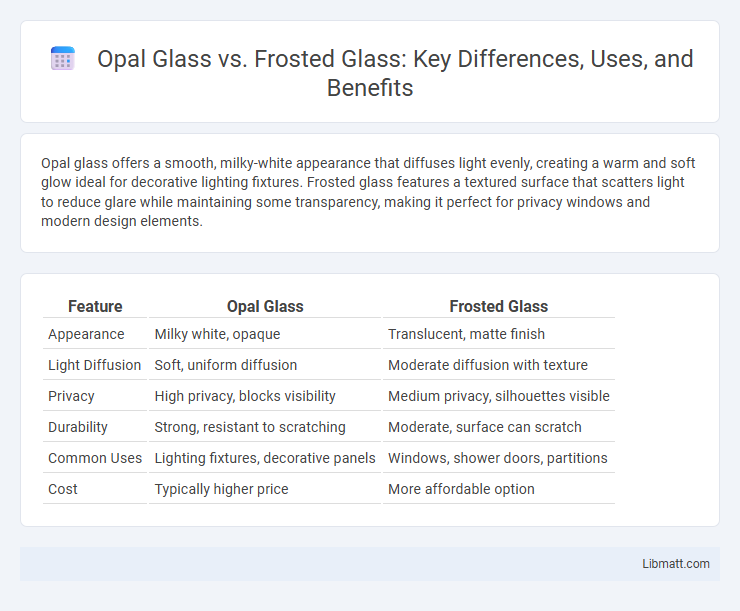Opal glass offers a smooth, milky-white appearance that diffuses light evenly, creating a warm and soft glow ideal for decorative lighting fixtures. Frosted glass features a textured surface that scatters light to reduce glare while maintaining some transparency, making it perfect for privacy windows and modern design elements.
Table of Comparison
| Feature | Opal Glass | Frosted Glass |
|---|---|---|
| Appearance | Milky white, opaque | Translucent, matte finish |
| Light Diffusion | Soft, uniform diffusion | Moderate diffusion with texture |
| Privacy | High privacy, blocks visibility | Medium privacy, silhouettes visible |
| Durability | Strong, resistant to scratching | Moderate, surface can scratch |
| Common Uses | Lighting fixtures, decorative panels | Windows, shower doors, partitions |
| Cost | Typically higher price | More affordable option |
Introduction to Opal Glass vs Frosted Glass
Opal glass offers a smooth, milky-white appearance that diffuses light evenly for a soft, uniform glow. Frosted glass features a textured, etched surface designed to obscure visibility while allowing light to pass through, creating privacy with a decorative effect. Choosing between opal and frosted glass depends on your preference for light diffusion and aesthetic style in lighting or interior design applications.
Composition and Manufacturing Process
Opal glass is composed primarily of silica, soda, and lime, with opacifiers like bone ash or tin oxide added during molten glass formation to create its characteristic milky white appearance. Frosted glass undergoes a surface treatment process such as acid etching or sandblasting, which roughens the clear glass exterior without altering its composition, diffusing light to achieve a translucent effect. While opal glass achieves opacity through inherent material additives in the melt, frosted glass attains translucency via post-production surface modification techniques.
Visual Appearance and Aesthetics
Opal glass features a smooth, milky-white finish that evenly diffuses light, creating a soft glow with a contemporary look ideal for minimalist interiors. Frosted glass has a textured, matte surface that scatters light more irregularly, offering subtle privacy while adding a tactile, decorative element to your space. Choosing between the two depends on whether you prefer the uniform luminosity of opal glass or the nuanced, artistic appeal of frosted glass for your design aesthetics.
Light Diffusion Capabilities
Opal glass offers superior light diffusion by evenly scattering light, reducing glare and creating a soft, uniform illumination, making it ideal for decorative lighting and fixtures requiring gentle luminosity. Frosted glass diffuses light through its etched or sandblasted surface, producing a muted glow while allowing some variation in light transmission and shadow effects. Opal glass provides a more consistent diffusion quality, whereas frosted glass balances privacy and light with slightly less uniform diffusion.
Durability and Strength Comparison
Opal glass typically offers higher durability and greater impact resistance compared to frosted glass due to its denser composition and uniform opaqueness. Frosted glass, created by acid etching or sandblasting, generally has a slightly reduced strength because its surface is microscopically roughened, which can introduce small stress points. For applications requiring robust performance under mechanical stress, opal glass is often preferred for its enhanced structural integrity and resistance to wear.
Common Applications and Uses
Opal glass is commonly used in lighting fixtures, such as lampshades and skylights, due to its excellent light diffusion and soft, uniform glow. Frosted glass finds frequent applications in privacy windows, shower enclosures, and office partitions, where obscured visibility is essential while still allowing natural light transmission. Both types of glass enhance aesthetic appeal and functional lighting but are chosen based on specific privacy or diffusion needs.
Maintenance and Cleaning Differences
Opal glass requires gentle cleaning with non-abrasive cloths and mild detergents to avoid surface damage, while frosted glass can tolerate more vigorous scrubbing due to its textured finish. You should avoid harsh chemicals on opal glass to preserve its smooth, glossy appearance, whereas frosted glass often resists fingerprints and smudges better, reducing frequent cleaning needs. Regular maintenance of both types ensures longevity, but opal glass demands more delicate care to maintain its pristine look.
Cost Considerations
Opal glass typically incurs higher costs due to its complex manufacturing process involving the dispersion of opacifiers that create its milky appearance. Frosted glass is generally more affordable, achieved through sandblasting or acid etching techniques that are less resource-intensive. Budget planning for architectural projects often favors frosted glass when cost efficiency is a priority without compromising on privacy and light diffusion.
Environmental Impact and Sustainability
Opal glass typically has a lower environmental impact due to its simpler manufacturing process and higher recyclability compared to frosted glass, which often requires chemical etching or sandblasting that increases energy consumption and waste. Frosted glass may contain coatings or treatments that complicate recycling efforts, leading to more landfill contributions. Choosing opal glass supports your sustainability goals by promoting eco-friendly production and easier material recovery.
Choosing the Right Glass for Your Needs
Opal glass offers superior light diffusion with a smooth, milky appearance that enhances privacy while maintaining brightness, making it ideal for bathrooms and office partitions. Frosted glass provides a textured, etched surface that obscures visibility more distinctly, perfect for decorative elements and areas requiring subtle design accents. Consider your need for light transmission, privacy level, and aesthetic preference when choosing the right glass for your space.
opal glass vs frosted glass Infographic

 libmatt.com
libmatt.com